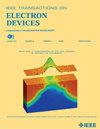Suppressed Capacitive Coupling in 2 Transistor Gain Cell With Oxide Channel and Split Gate
IF 2.9
2区 工程技术
Q2 ENGINEERING, ELECTRICAL & ELECTRONIC
引用次数: 0
Abstract
In this article, the impact of capacitive coupling in the oxide-channel-based 2 transistor gain cell (2TGC) is evaluated. The study is performed using an experimentally calibrated TCAD model of W-doped In2O3 transistor (IWO MOSFET) in the mixed mode simulation. A write “0,” read “0,” write “1,” read “1” (W0R0W1R1) operation is performed and the storage node (SN) potential is monitored. The SN is capacitively coupled to write and read wordlines (WWL and RWL), which temporarily lowers the SN potential after writing and during a read operation. For an improperly designed 2TGC, capacitive coupling leads to a disturbed read for bit “0,” and reduced sense margin for bit “1.” To mitigate this problem,采用氧化物沟道和分裂栅极的双晶体管增益单元中的抑制电容耦合
本文评估了基于氧化物沟道的双晶体管增益单元 (2TGC) 中电容耦合的影响。研究采用混合模式仿真中经实验校准的掺 W In2O3 晶体管(IWO MOSFET)TCAD 模型。执行写 "0"、读 "0"、写 "1"、读 "1"(W0R0W1R1)操作,并监测存储节点(SN)电位。SN 与写入和读取字线(WWL 和 RWL)电容耦合,在写入后和读取操作期间会暂时降低 SN 电位。对于设计不当的 2TGC,电容耦合会导致位 "0 "的读取受到干扰,位 "1 "的感应裕度降低。为缓解这一问题,{V}_{text {TH}}$ 工程设计、{V}_{text {HOLD}}$ 的适当选择以及单个晶体管的大小都很有帮助。为了大幅抑制电容耦合,我们提出了一种 IWO MOSFET 的分裂栅(SpG)结构设计,它允许采用与尺寸大小无关的 2TGC 设计,与传统设计相比,具有不受干扰的读取和更高的感应裕度。
本文章由计算机程序翻译,如有差异,请以英文原文为准。
求助全文
约1分钟内获得全文
求助全文
来源期刊

IEEE Transactions on Electron Devices
工程技术-工程:电子与电气
CiteScore
5.80
自引率
16.10%
发文量
937
审稿时长
3.8 months
期刊介绍:
IEEE Transactions on Electron Devices publishes original and significant contributions relating to the theory, modeling, design, performance and reliability of electron and ion integrated circuit devices and interconnects, involving insulators, metals, organic materials, micro-plasmas, semiconductors, quantum-effect structures, vacuum devices, and emerging materials with applications in bioelectronics, biomedical electronics, computation, communications, displays, microelectromechanics, imaging, micro-actuators, nanoelectronics, optoelectronics, photovoltaics, power ICs and micro-sensors. Tutorial and review papers on these subjects are also published and occasional special issues appear to present a collection of papers which treat particular areas in more depth and breadth.
 求助内容:
求助内容: 应助结果提醒方式:
应助结果提醒方式:


